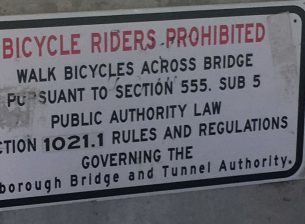LAST MINUTE PUSH: Legislators Hope to Get Cyclists And Pedestrians A Voice At The MTA

It’s not a bridge too far.
Activists and bike-friendly legislators are making a final push to get a floor vote for a stalled bill that would bring cyclist and pedestrian input to the MTA’s planning process, a longtime oversight and sore spot for anyone who’s tried to bike over an MTA bridge such as the Triboro or Gil Hodges.
The bill, one version, A6235, sponsored by Assembly Member Jessica González-Rojas and its counterpart S4943 by state Senator Alessandra Biaggi, would add the mellifluous voice of cyclists and pedestrians to the MTA planning process to ensure that the authority takes their concerns seriously when it considers future plans.
González-Rojas said that the she’d been aggressively promoting the bill in the waning days of the legislative session, which ends on June 10. The bill is currently in the Assembly Ways and Means Committee, where it will be debated Wednesday amid a slew of bills that legislators are hoping to get out the door before they leave Albany. The bill would then be moved to the Rules committee to get a floor vote by the end of the day on Thursday, but the Assembly member said she was confident it would get there. (The senate version is already calendared for a vote.)
Nothing has changed as far as the legislation’s aim of getting the MTA to take cyclists seriously, which could lead to a world where it’s actually legal to bike across the bridges that the authority controls or even a day where bringing your bike on a train isn’t subject to seemingly arbitrary restrictions. It could also mean that the next time something like Moynihan Station gets built, there’s a bike rack or even a secure bike parking facility in the final design.
What did change is the way that cyclists and pedestrians will have their voices heard. González-Rojas said that instead of creating a new committee inside the MTA, the bill will now add cycling and pedestrian representatives to the MTA’s rider councils for New York City Transit, Metro-North and Long Island Rail Road. Those experts would still be in charge of creating a strategic plan to better integrate cyclist and pedestrian viewpoints into the MTA’s larger process, which the the Assembly member said would give the law more than just a ceremonial sheen.
“Ultimately, the charge didn’t change, they still have to come up with a strategic plan to address cycling and pedestrian access on the MTA bridges,” said González-Rojas. “Where it’s unique is that the appointees would have to be a subject matter expert on cycling and pedestrian safety and advocacy. Which is good, because while I was a member of a New York City Transit Riders Council, it wasn’t mandated to have expertise to be on it. They just try to get a diverse set of transit riders, but this would require expertise, or subject matter expert on this issue.”
A spokesperson for Speaker Carl Heastie’s office did not return a request for comment, but cycling advocates have kept up the pressure on the leader of the Assembly (and you can too).
OK #bikenyc!
Hearing we are close with the #MTABikeAccess bill in Albany!
The key is getting a vote in the Assembly
Please urge Speaker @CarlHeastie to move @votejgr's #MTABikeAccess bill to the floor *today*
The MTA must plan for ? on bridges & at its stations! pic.twitter.com/MO0cwzqd8K
— Bike New York (@bikenewyork) June 8, 2021
“We need the legislature to act,” said Bike New York Director of Advocacy Jon Orcutt. “Even if the law passes, it will only be the start of a long process bringing the MTA to 21st Century transportation planning. This first step shouldn’t be a big lift for the Assembly.”

